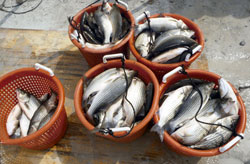Aquaculture Programs

Food Production
The decline of traditional capture fisheries in waters around the United States and in distant water fisheries has encouraged the farmed production of a wide variety of fish, shellfish, crustaceans and plants. Current world statistics describe wild capture fisheries as steady or declining at 75-80 million metric tons annual yield. Coupled with world human population growth, which is expected to reach to 8.5 billion people by 2025, these factors provide tremendous opportunity for aquaculture development and market expansion worldwide. While current aquaculture production accounts  for 24% of all seafood consumed, by 2025 global demand for aquaculture products will have increased five-fold to 75 million metric tons - about 48% of total demand. Operating within a globally competitive climate, US aquaculture has steadily increased its output to a 1998 farm-gate value of $875 million and an estimated economic value of $6.1 billion. In addition, it provides over 197,000 full time jobs and is the fastest growing sector of U.S. agriculture. Despite such impressive growth, the US ranks only tenth in the world with less than 2% of global aquaculture value. We currently import nearly 60% of our seafood which significantly impacts our balance of trade.
for 24% of all seafood consumed, by 2025 global demand for aquaculture products will have increased five-fold to 75 million metric tons - about 48% of total demand. Operating within a globally competitive climate, US aquaculture has steadily increased its output to a 1998 farm-gate value of $875 million and an estimated economic value of $6.1 billion. In addition, it provides over 197,000 full time jobs and is the fastest growing sector of U.S. agriculture. Despite such impressive growth, the US ranks only tenth in the world with less than 2% of global aquaculture value. We currently import nearly 60% of our seafood which significantly impacts our balance of trade.
 With its long coatline and favorable climate SC is well positioned to expand aquaculture production. Despite challenges associated with high costs labor; regulation; water quality problems and limited seed availability, with the passage of the aquaculture enabling act of 2004, growers have new opportunities for industry expansion. It is the policy of the SCDNR to support aquaculture research and development while providing safeguards for the state’s natural resources. At the MRRI facilities in Charleston and Bluffton, SC, research is carried out on fish and shrimp to develop commercially viable production technologies and to transfer them to the private sector.
With its long coatline and favorable climate SC is well positioned to expand aquaculture production. Despite challenges associated with high costs labor; regulation; water quality problems and limited seed availability, with the passage of the aquaculture enabling act of 2004, growers have new opportunities for industry expansion. It is the policy of the SCDNR to support aquaculture research and development while providing safeguards for the state’s natural resources. At the MRRI facilities in Charleston and Bluffton, SC, research is carried out on fish and shrimp to develop commercially viable production technologies and to transfer them to the private sector.
